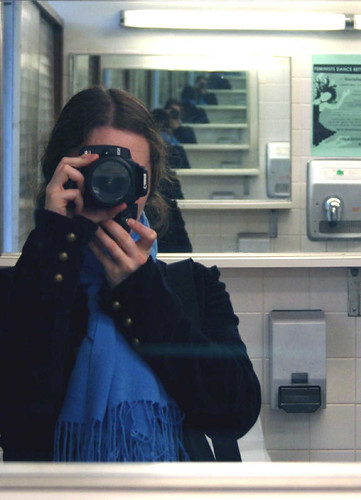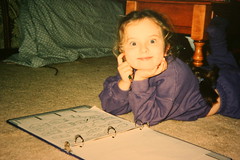 My prof had suggested it to me, and then I had forgotten all about it until Alison called. "We should go see this documentary that's screening downtown," she said, and asked me if it was alright if she brought a friend along. "I don't know if you've met..." she started.
My prof had suggested it to me, and then I had forgotten all about it until Alison called. "We should go see this documentary that's screening downtown," she said, and asked me if it was alright if she brought a friend along. "I don't know if you've met..." she started.
"Blonde and training to be in the RCMP," I replied, to her surprise. Apparently the other friend did pretty much the same thing to her when she mentioned my name, only she said something to the tune of "she was at your birthday. We ate Thai."
I arrived a little early to find that seating was already quite limited. My friends arrived during the very beginning of the show, so there wasn't exactly time or room for them to sit anywhere near me.
The film? It was called Beyond Words: Photographers of War and I would definitely recommend it.
The idea behind it was that there are so many famous images that come to mind whenever we think of certain conflicts, and yet most of us have never had the chance to see the people behind the cameras and hear their stories.
Some questions that the photographers wrestled with in the film were how to draw the line between making art and depicting human misery, how to decide whether an image was fit for print or too graphic, or whether or not their work actually made a difference. Each person had a different answer to each.
While on the one hand, photographers are always looking for good pictures, ones that are visually arresting, descriptive and suitable for publication, the point of the game is to evoke compassion and empathy, not have the reader say "wow, nice shot". One of the photographers showed a picture that he had taken of a soldier propped up by two comrades, his arms spread out, across their shoulders. Both his legs had been wounded and his head lolled to the side. "It's the classic crucifixion," he said, "but you have to be very conscious and not frame it as such."
Another complained about how the medium of photography makes it difficult to show what's actually going on. He had been in stationed somewhere in former Yugoslavia, photographing a near-constant stream of refugees, and was frustrated that while the situation he was in was chaotic all his photos were composed and orderly.
The film drew a parallel between two people with similar stories about pictures of people kicking severed heads. One decided that that was not fit for print, and the other decided that it was something that the public absolutely had to see. And yet each was extremely well respected, each a professional with tons of experience.
The general consensus for the last question was that war photography doesn't really make a huge difference. There is no picture to end all wars, and repeated images of human pain and suffering don't seem to be able to motivate people to act against it. And yet there was a bit of hope there, a little bit of idealism and a belief that over time, what they were doing could help, and the knowledge that things that have not been observed and recorded never really existed in the first place.
It's strange how some images gain new meaning when you hear the story behind them. The one that comes to mind was a series of pictures of a little girl in a Bagdhad hospital. Visually, they weren't all that good, as the photographer had taken them as quickly as he could, without thought of composition. What made them powerful was the fact that this hardened professional was brought to tears describing how he watched her die.
A part of the film was dedicated to a criticism of today's lowest-common-denominator infotainment journalism, and the fact that there really aren't very many places for war photographers to sell their photos to anymore. The profession appears on the decline, and may possibly be dying out. Journalism is becoming increasingly patronizing, commercially oriented and in spite of all the hope and glamour of the internet as a 'democratic' medium, I don't see it changing much. Those in charge seem to think that we should be spoonfed.
The only other question that I would have wanted answered was whether or not the presence of the photographer affects events and peoples' actions. In the discussion after the film, filmmaker Greg Kelly said that though the question was asked in interviews, no one was really prepared to answer it.
Some of the images were graphic and apparently too graphic for the film to be shown on anything other than CBC Newsworld, and I think that is a shame. It's well worth a watch.
Sunday, November 05, 2006
Beyond Words
Posted by
erin
at
6:08 PM
![]()
Subscribe to:
Comment Feed (RSS)







|